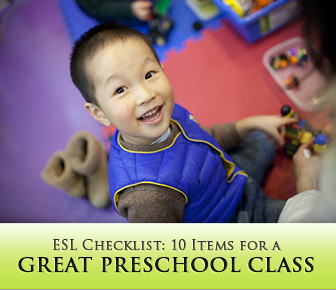ESL Checklist: 10 Items for a Great Preschool Class


Additionally if students are very loud and energetic at the very beginning of class, you will have to curb their excitement a little in order to complete the rest of the activities for your lesson.
Here are some strategies for dealing with students who are bouncing off the walls of your classroom.
Sit down
Students who are seated are more restrained and subdued. If students are running around the classroom or having a heated discussion, ask everyone to go back to their desks and sit down. The physical state of sitting in their chairs will help them relax. Standing is a great stance for action while sitting is more a state of rest. Some students may fidget at their desks but sitting is already a big improvement and this is less likely to distract other students. Once learners have taken their seats, shift their focus immediately to an activity so that they do not become bored or lose interest in the lesson. It is important for students to focus their energy on learning English so help them put it to good use by effectively managing your classroom.
Exercise
An activity requiring lots of energy that will tire students out could make them a little more calm during the rest of your lesson. If your young learners cannot sit still at the beginning of class, give them the chance to use that energy during the warm up (see our growing collection of warmers and fillers, or add one yourself!) and then continue with your lesson. Some simple TPR games like Head and Shoulders or Simon Says would be perfect for reviewing body parts, writing relays would be good for slightly older students and even just simple exercises like jumping jacks or running in place should help learners settle down. For some students these types of exercises will actually energize them more so experiment to see what works best with your classes. Different groups of students may require different tactics.
Quiet time
Active exercises can be a lot of fun, especially with young learners, but after students have gotten out of their seats and moved around a bit, bring their heart rates down with a quiet activity such as reading or writing. Students can take their time silently reading through an article or begin writing their individual answers to short answer or essay questions before you turn these activities into class activities to check pronunciation, comprehension, and grammar points. These types of activities are good for calming a class down but should be avoided if students lack energy as you risk them falling asleep.
Focus
Get students to really focus by conducting an activity such as a circle exercise or something similar that is fast paced. This will take advantage of their energy but because they never know whose turn it will be next, they have to be quiet and pay attention in order to perform their part well. Another game that is exciting but requires that students remain calm and quiet is Chinese Whispers where students work in teams to see who can correctly pass a sentence from team member to team member the fastest.
Topics
A topic that interests your students will also make them more attentive. Keep your learners in mind when deciding what to talk about in class. Students who are focused will not have the inclination to move around a lot nor will they be easily distracted. These are both likely to happen if students are overly excited or energized. If you are not sure what your students are interested in, simply ask them or take a poll of various topics to see what they are most eager to learn about.
Be sure to use the one that will be most efficient for the type of students you have in your classroom. Luckily this becomes less of a problem as students get older and in adult classes you will rarely have similar issues. If you struggle with this, change your approach to classes in order to resolve it and look on the bright side, at least no one is sleeping.